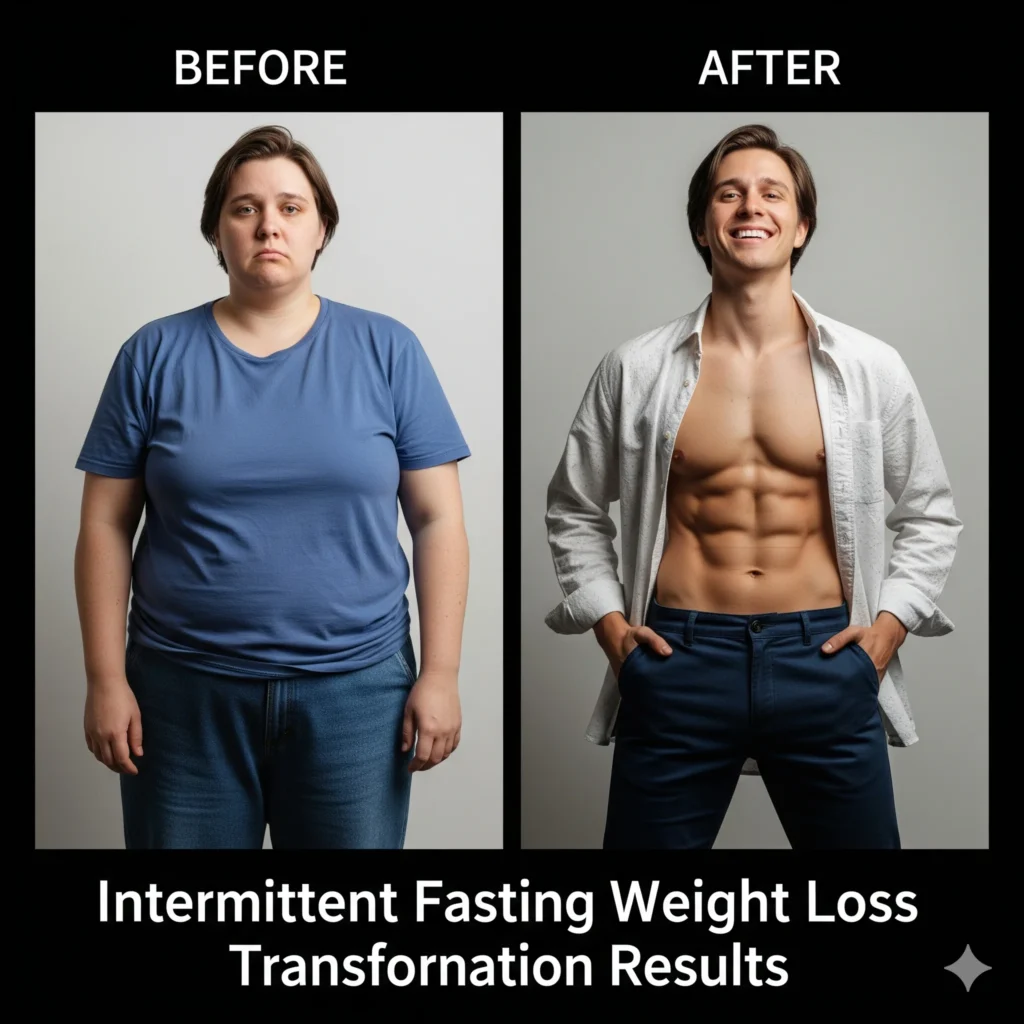Introduction
Intermittent fasting for weight loss has emerged as one of the most researched and effective approaches to sustainable fat loss in recent years. Unlike traditional dieting methods that focus on what you eat, intermittent fasting revolutionizes when you eat, creating powerful metabolic changes that naturally promote weight loss, improve insulin sensitivity, and enhance overall health.
This comprehensive guide explores everything you need to know about intermittent fasting for weight loss, from the science behind its effectiveness to practical implementation strategies. Whether you’re a complete beginner or looking to optimize your current fasting routine, you’ll discover proven methods, expert tips, and real-world strategies to achieve lasting results.
With over 40 clinical studies supporting its benefits, intermittent fasting has helped millions of people worldwide achieve their weight loss goals while improving their relationship with food. Let’s dive into how you can harness this powerful tool to transform your body and health.
Intermittent Fasting Methods Comparison Chart
1. 16:8 Method
- Description: Fast for 16 hours each day, with an 8-hour eating window.
- Typical Fasting Window: 16 hours fasting, 8 hours eating (e.g., eat between 12 p.m. and 8 p.m.).
- Pros: Simple and sustainable for many; most fasting occurs overnight.
- Cons: May be difficult to skip breakfast or eat a late dinner.
2. 14:10 Method
- Description: A less restrictive form of time-restricted eating, with a 14-hour fast and a 10-hour eating window.
- Typical Fasting Window: 14 hours fasting, 10 hours eating (e.g., eat between 9 a.m. and 7 p.m.).
- Pros: Good for beginners as it’s not as demanding.
- Cons: May not provide as significant benefits as longer fasts.
3. 5:2 Diet
- Description: Eat normally for 5 days of the week, and restrict calories to 500-600 on the other 2 non-consecutive days.
- Typical Fasting Window: 2 days with calorie restriction, 5 days normal eating.
- Pros: Flexible as you can choose your fasting days.
- Cons: Calorie counting on fasting days can be challenging; some people find this method difficult to stick to.
4. Eat-Stop-Eat
- Description: Involves a full 24-hour fast once or twice a week.
- Typical Fasting Window: 24 hours fasting, 1-2 times per week (e.g., fast from dinner one day to dinner the next).
- Pros: Can be a good “reset” for your body.
- Cons: Can cause fatigue, headaches, and irritability.
5. Alternate-Day Fasting
- Description: Fast every other day. Some variations allow for a small number of calories (e.g., 500) on fasting days.
- Typical Fasting Window: Alternates between “fasting” and “eating” days.
- Pros: May lead to significant weight loss.
- Cons: Very restrictive and can be challenging to maintain long-term.
6. The Warrior Diet
- Description: Fast for 20 hours each day, and have a single large meal within a 4-hour eating window at night.
- Typical Fasting Window: 20 hours fasting, 4 hours eating.
- Pros: Aligns with natural eating rhythms for some; simplifies meal planning.
- Cons: Very intense and may lead to nutritional deficiencies if not done carefully.
7. One Meal a Day (OMAD)
- Description: This method involves eating all of your daily calories in a single meal.
- Typical Fasting Window: 23 hours fasting, 1 hour eating.
- Pros: Very simple and removes the need for multiple meals.
- Cons: Can be difficult to get all necessary nutrients in one meal; may cause fatigue or hunger.
What is Intermittent Fasting and How Does It Work for Weight Loss?
Intermittent fasting (IF) is an eating pattern that cycles between periods of eating and fasting. Rather than restricting specific foods, intermittent fasting for weight loss focuses on timing your meals to optimize your body’s natural fat-burning processes.
The Science Behind Intermittent Fasting Weight Loss
When you fast, several metabolic changes occur that promote weight loss:
Insulin Sensitivity Improvement: During fasting periods, insulin levels drop significantly, allowing your body to access stored fat for energy. Lower insulin levels also reduce fat storage, making it easier to maintain a healthy weight.
Increased Growth Hormone: Fasting can increase growth hormone levels by up to 300%, which helps preserve lean muscle mass while promoting fat loss. This hormonal boost is crucial for maintaining metabolic rate during weight loss.
Enhanced Fat Oxidation: After 12-16 hours of fasting, your body shifts from glucose to fat as its primary fuel source, a metabolic state called ketosis. This transition significantly accelerates fat burning and weight loss.
Cellular Repair Processes: Fasting triggers autophagy, a cellular cleaning process that removes damaged proteins and organelles. This process not only supports longevity but also optimizes cellular function for better metabolism.
Primary Mechanisms of Weight Loss Through Intermittent Fasting
The weight loss benefits of intermittent fasting stem from several key mechanisms:
- Caloric Restriction: By limiting eating windows, most people naturally consume fewer calories without conscious effort.
- Metabolic Flexibility: Regular fasting improves your body’s ability to switch between glucose and fat as fuel sources.
- Appetite Regulation: Fasting helps normalize hunger hormones like ghrelin and leptin, reducing cravings and emotional eating.
- Inflammation Reduction: Intermittent fasting decreases chronic inflammation, which is linked to weight gain and metabolic dysfunction.
Top 7 Intermittent Fasting Methods for Maximum Weight Loss
Choosing the right intermittent fasting method is crucial for long-term success. Here are the most effective approaches for weight loss:
1. 16:8 Method (Time-Restricted Eating)
The 16:8 method is the most popular form of intermittent fasting for weight loss. You fast for 16 hours and eat within an 8-hour window daily.
How it works: Skip breakfast and eat between 12 PM and 8 PM, or adjust the window to fit your schedule.
Weight loss benefits: This method is sustainable and allows for social flexibility while providing consistent fat-burning benefits.
Best for: Beginners and people with regular work schedules who want steady, sustainable weight loss.
2. 18:6 Method (Extended Time-Restricted Eating)
This approach extends the fasting window to 18 hours with a 6-hour eating period.
Implementation: Eat between 2 PM and 8 PM, or 12 PM and 6 PM.
Weight loss advantages: Longer fasting periods increase fat oxidation and improve insulin sensitivity more dramatically than shorter fasts.
Ideal candidates: Individuals comfortable with 16:8 who want to accelerate their weight loss results.
3. 20:4 Method (Warrior Diet)
The 20:4 approach involves fasting for 20 hours and eating within a 4-hour window.
Protocol: Consume all daily calories within a 4-hour period, typically 4 PM to 8 PM.
Weight loss mechanism: Extended fasting maximizes growth hormone production and fat burning while significantly reducing overall caloric intake.
Suitable for: Experienced fasters who can manage longer periods without food and want rapid weight loss results.
4. 5:2 Diet (Modified Intermittent Fasting)
This method involves eating normally five days per week and restricting calories to 500-600 on two non-consecutive days.
Structure: Choose two days (e.g., Tuesday and Friday) for low-calorie intake while maintaining normal eating on other days.
Weight loss benefits: Provides metabolic benefits of fasting while allowing more dietary flexibility throughout the week.
Perfect for: People who struggle with daily fasting but can handle periodic calorie restriction.
“To better understand the science, methods, and real-life applications of intermittent fasting, you can explore Healthline’s Intermittent Fasting 101 guide for a comprehensive and beginner-friendly overview.”
5. Eat-Stop-Eat Method
This approach involves 24-hour fasts once or twice per week.
Implementation: Fast from dinner one day to dinner the next day, maintaining normal eating on non-fasting days.
Weight loss effectiveness: Complete 24-hour fasts maximize autophagy and fat burning while providing significant caloric reduction.
Best suited for: Experienced fasters who want maximum metabolic benefits and can handle extended periods without food.
6. Alternate Day Fasting (ADF)
ADF alternates between normal eating days and fasting days (consuming 25% of normal calories).
Protocol: Eat normally one day, fast or eat 500-600 calories the next day, repeating this cycle.
Weight loss potential: Studies show ADF can produce 3-8% body weight loss in 2-12 weeks.
Recommended for: Individuals seeking rapid weight loss who can maintain consistency with alternating patterns.
7. Extended Fasting (48-72 Hours)
Longer fasting periods performed occasionally for enhanced metabolic benefits.
Approach: Fast for 48-72 hours once per month with proper medical supervision.
Weight loss impact: Extended fasts reset metabolism, maximize autophagy, and can break weight loss plateaus.
Important note: Only attempt extended fasting with medical supervision and after establishing comfort with shorter fasting periods.

Intermittent Fasting Benefits Beyond Weight Loss
While weight loss is often the primary goal, intermittent fasting offers numerous additional health benefits:
Metabolic Health Improvements
Blood Sugar Regulation: Intermittent fasting improves insulin sensitivity by 20-31%, reducing type 2 diabetes risk and supporting weight management.
Cholesterol Optimization: Studies show IF can reduce total cholesterol by 6-21% and LDL cholesterol by 7-32%, improving cardiovascular health.
Metabolic Rate Enhancement: Contrary to traditional calorie restriction, short-term fasting can increase metabolic rate by 3.6-14%, supporting sustained weight loss.
Cardiovascular Benefits
Regular intermittent fasting supports heart health through multiple mechanisms:
- Reduced blood pressure (5-20 mmHg systolic reduction)
- Improved heart rate variability
- Decreased inflammation markers
- Enhanced endothelial function
Brain Health and Cognitive Function
Neuroplasticity Enhancement: Fasting increases brain-derived neurotrophic factor (BDNF), supporting new neural connections and cognitive function.
Neuroprotection: Intermittent fasting may reduce risk of neurodegenerative diseases like Alzheimer’s and Parkinson’s.
Mental Clarity: Many practitioners report improved focus, concentration, and mental energy during fasting periods.
Anti-Aging Effects
Cellular Repair: Autophagy activation during fasting removes damaged cellular components, potentially slowing aging processes.
Longevity Pathways: Fasting activates sirtuins and other longevity-promoting genes similar to caloric restriction.
Oxidative Stress Reduction: IF decreases markers of oxidative stress and inflammation associated with aging.
“While intermittent fasting offers many metabolic perks, occasional extended fasting—such as a 72-hour water fast—can further enhance autophagy, cellular repair, and insulin sensitivity. For a deeper dive into this advanced approach, check this 72-Hour Fast benefits guide from HealthMorph.”

Creating Your Intermittent Fasting Meal Plan for Optimal Weight Loss
Proper nutrition during eating windows is crucial for maximizing weight loss results with intermittent fasting.
Macronutrient Distribution for Weight Loss
Protein Requirements: Aim for 0.8-1.2 grams per pound of body weight to preserve lean muscle mass during weight loss.
Healthy Fats: Include 20-30% of calories from sources like avocados, nuts, olive oil, and fatty fish to support hormone production and satiety.
Strategic Carbohydrates: Focus on complex carbohydrates like vegetables, legumes, and whole grains, timing them around workouts for optimal utilization.
Sample 16:8 Intermittent Fasting Meal Plan
First Meal (12 PM – Breaking the Fast):
- Large salad with mixed greens, cherry tomatoes, cucumber, and grilled chicken breast
- Olive oil and lemon dressing
- 1/2 avocado
- Side of quinoa or sweet potato
Afternoon Snack (3 PM):
- Greek yogurt with berries and almonds
- Or apple slices with almond butter
Dinner (7 PM – Last Meal):
- Grilled salmon or lean protein of choice
- Steamed broccoli and asparagus
- Brown rice or cauliflower rice
- Mixed nuts (small portion)
Hydration and Supplements During Fasting
Electrolyte Balance: Maintain sodium, potassium, and magnesium levels with sugar-free electrolyte supplements or sea salt in water.
Beneficial Supplements: Consider magnesium, vitamin D, and omega-3s to support overall health during weight loss.
Fasting-Safe Beverages: Black coffee, plain tea, sparkling water, and water with lemon are acceptable during fasting periods.
Intermittent Fasting Results: What to Expect and When
Understanding realistic timelines and expectations is crucial for long-term success with intermittent fasting for weight loss.
Week 1-2: Initial Adaptation
Physical Changes: Many people experience initial hunger adjustment, potential fatigue, and mild headaches as the body adapts to new eating patterns.
Weight Loss: Expect 1-3 pounds of weight loss, primarily from water weight and glycogen depletion.
Energy Levels: Some individuals experience increased mental clarity, while others may feel temporarily low energy as they adapt.
Week 3-4: Metabolic Adaptation
Fat Burning Optimization: Your body becomes more efficient at utilizing fat for fuel, leading to more consistent energy levels.
Appetite Regulation: Hunger patterns typically normalize, with reduced cravings and better satiety signals.
Sustainable Weight Loss: Expect 1-2 pounds of fat loss per week with proper implementation.
Month 2-3: Established Benefits
Significant Body Composition Changes: Noticeable reductions in waist circumference and overall body fat percentage.
Improved Biomarkers: Better insulin sensitivity, improved lipid profiles, and reduced inflammation markers.
Lifestyle Integration: Intermittent fasting becomes a natural part of daily routine rather than a conscious effort.
Long-term Results (3+ Months)
Sustained Weight Loss: Total weight loss of 5-15% of initial body weight is common with consistent practice.
Metabolic Health: Significant improvements in insulin sensitivity, blood pressure, and cholesterol levels.
Quality of Life: Enhanced energy, better sleep quality, and improved relationship with food.

Safety Considerations and Who Should Avoid Intermittent Fasting
While intermittent fasting is safe for most healthy adults, certain populations should exercise caution or avoid IF altogether.
Contraindications for Intermittent Fasting
Medical Conditions Requiring Caution:
- Type 1 diabetes or poorly controlled type 2 diabetes
- History of eating disorders
- Chronic kidney disease
- Active cancer treatment
- Pregnancy or breastfeeding
- Severe heart conditions
Medications Affecting Fasting:
- Blood sugar medications requiring food timing
- Blood pressure medications
- Certain psychiatric medications
- Blood thinners
Common Side Effects and Management
Initial Hunger: Gradually extend fasting periods rather than jumping into long fasts immediately.
Headaches: Often due to dehydration or electrolyte imbalance; increase water and salt intake.
Fatigue: Usually temporary as the body adapts; ensure adequate sleep and manage stress.
Digestive Issues: Introduce fasting gradually and focus on nutrient-dense foods during eating windows.
When to Consult a Healthcare Provider
Seek medical guidance before starting intermittent fasting if you:
- Take medications for chronic conditions
- Have a history of eating disorders
- Experience persistent side effects
- Are pregnant, breastfeeding, or trying to conceive
- Have significant health concerns or medical history
Optimizing Exercise with Intermittent Fasting for Enhanced Weight Loss
Combining strategic exercise with intermittent fasting can significantly accelerate weight loss results while preserving lean muscle mass.
Fasted Training Benefits
Enhanced Fat Oxidation: Exercising in a fasted state increases fat burning by 20-30% compared to fed-state training.
Improved Insulin Sensitivity: Fasted exercise further enhances insulin sensitivity improvements from intermittent fasting.
Growth Hormone Boost: Combining fasting with exercise can increase growth hormone levels by up to 500%.
Best Exercise Types During Fasting
Low-Intensity Steady State (LISS):
- Walking, light jogging, or cycling
- Optimal for fat burning without excessive stress
- Can be performed comfortably during fasting periods
High-Intensity Interval Training (HIIT):
- Short bursts of intense activity followed by rest
- Maximizes post-exercise oxygen consumption (EPOC)
- Best performed near the end of fasting window
Strength Training Considerations:
- May be challenging during longer fasts
- Focus on compound movements for maximum benefit
- Consider timing workouts before breaking fast for post-workout nutrition
Exercise Timing Strategies
Morning Fasted Cardio: Perform low-intensity cardio after waking during fasting period for maximum fat oxidation.
Pre-Meal Strength Training: Schedule weight training 1-2 hours before breaking fast to take advantage of post-workout protein synthesis.
Evening Activity: Light walks or yoga during fasting periods can help manage hunger and improve sleep quality.
Beyond fasting, incorporating natural superfoods can support your metabolic health and immunity. For example, raw onions are rich in quercetin and sulfur compounds that reduce inflammation and may aid fat-burning—learn more in this insightful benefits of eating raw onion guide.”
Troubleshooting Common Intermittent Fasting Challenges
Even with proper planning, you may encounter obstacles during your intermittent fasting journey. Here’s how to overcome common challenges:
Breaking Through Weight Loss Plateaus
Vary Fasting Protocols: Alternate between different IF methods to prevent metabolic adaptation.
Refeed Days: Incorporate periodic higher-calorie days to reset metabolism and hormones.
Exercise Modifications: Change workout intensity, duration, or type to stimulate new adaptations.
Sleep Optimization: Prioritize 7-9 hours of quality sleep to support weight loss hormones.
Managing Social Situations
Flexible Eating Windows: Adjust fasting schedule around social events when necessary.
Communication Strategies: Explain your eating pattern to friends and family to gain support.
Non-Food Social Activities: Suggest activities that don’t revolve around eating.
Dealing with Hunger and Cravings
Distraction Techniques: Engage in activities that occupy your mind during difficult hunger periods.
Hydration Focus: Often thirst masquerades as hunger; increase water intake before assuming you need food.
Gradual Progression: Extend fasting periods slowly to allow natural appetite adjustment.
Stress Management: Practice meditation, deep breathing, or other stress-reduction techniques to minimize emotional eating triggers.
“For those looking to elevate their intermittent fasting regimen, occasional 72-hour fasts can significantly boost autophagy and cellular repair mechanisms. Discover a complete, science-backed breakdown of the benefits, risks, and best practices in this 72-Hour Fast benefits guide.”
Advanced Intermittent Fasting Strategies for Experienced Practitioners
Once you’ve established a solid foundation with basic intermittent fasting protocols, consider these advanced strategies to optimize results:
Cycling Fasting Methods
Weekly Rotation: Alternate between different fasting protocols throughout the week (e.g., 16:8 on weekdays, 20:4 on weekends).
Monthly Progression: Gradually increase fasting windows over monthly cycles to prevent adaptation.
Seasonal Adjustments: Modify fasting intensity based on activity levels, stress, and life circumstances.
Targeted Nutrient Timing
Post-Workout Nutrition: Time protein and carbohydrate intake strategically around workouts for optimal recovery and muscle preservation.
Micronutrient Timing: Schedule nutrient-dense foods early in eating windows for maximum absorption.
Supplementation Strategy: Use specific supplements like branched-chain amino acids (BCAAs) or electrolytes to support extended fasting periods.
Biohacking Integration
Heart Rate Variability Monitoring: Use HRV data to adjust fasting intensity based on recovery status.
Continuous Glucose Monitoring: Track blood sugar responses to optimize meal timing and composition.
Sleep Tracking: Monitor sleep quality to ensure fasting practices aren’t negatively impacting recovery.
Frequently Asked Questions About Intermittent Fasting for Weight Loss
Can I drink coffee during my fasting window?
Yes, black coffee is acceptable during fasting periods and may even enhance fat burning through caffeine’s thermogenic effects. Avoid adding cream, sugar, or artificial sweeteners that could break your fast.
How much weight can I lose with intermittent fasting?
Weight loss varies based on starting weight, adherence, and individual factors. Most people lose 1-2 pounds per week consistently, with total losses ranging from 5-15% of body weight over 3-6 months.
Will intermittent fasting slow my metabolism?
Short-term fasting (up to 72 hours) typically increases metabolic rate by 3.6-14%. Only extended caloric restriction over weeks or months may slow metabolism, which is why intermittent fasting is superior to constant calorie restriction.
Can I exercise while fasting?
Yes, exercising during fasting periods can enhance fat burning. Start with low-intensity activities and gradually progress to more intense workouts as your body adapts.
What should I eat when I break my fast?
Focus on nutrient-dense, whole foods including lean proteins, healthy fats, and complex carbohydrates. Avoid processed foods and excessive sugars that could cause insulin spikes.
Is intermittent fasting safe for women?
Women may need to approach intermittent fasting more cautiously due to hormonal sensitivities. Consider shorter fasting windows initially and monitor menstrual cycle regularity.
How long should I try intermittent fasting before seeing results?
Most people notice initial changes within 2-3 weeks, with significant weight loss and health improvements occurring after 4-8 weeks of consistent practice.
Can I take supplements during fasting?
Most supplements are acceptable during fasting windows, though fat-soluble vitamins may be better absorbed with food. Consult with a healthcare provider about specific supplement timing.
Creating Long-term Success with Intermittent Fasting
Sustainable weight loss requires more than just following a fasting protocol; it demands lifestyle integration and continuous optimization.
Building Sustainable Habits
Gradual Implementation: Start with shorter fasting periods and gradually extend them as your body adapts.
Consistency Over Perfection: Aim for 80% adherence rather than perfect compliance to maintain long-term sustainability.
Flexibility Integration: Allow for life’s interruptions while maintaining overall commitment to your fasting schedule.
Monitoring Progress Beyond the Scale
Body Measurements: Track waist circumference, body fat percentage, and how clothing fits rather than focusing solely on weight.
Energy Levels: Monitor daily energy, mood, and cognitive function as indicators of overall health improvement.
Biomarker Tracking: Consider periodic blood tests to assess metabolic health improvements including insulin sensitivity and lipid profiles.
Long-term Maintenance Strategies
Periodic Assessments: Regularly evaluate your fasting protocol’s effectiveness and make adjustments as needed.
Community Support: Connect with others practicing intermittent fasting for motivation and accountability.
Professional Guidance: Consider working with a healthcare provider or nutritionist familiar with intermittent fasting for personalized optimization.
Conclusion: Your Path to Sustainable Weight Loss Through Intermittent Fasting
Intermittent fasting for weight loss represents a scientifically-backed approach that goes far beyond simple calorie restriction. By harnessing your body’s natural metabolic processes, IF can help you achieve sustainable weight loss while improving overall health, increasing energy levels, and enhancing your relationship with food.
The key to success lies in choosing the right fasting method for your lifestyle, implementing it gradually, and maintaining consistency over time. Whether you start with the beginner-friendly 16:8 method or progress to more advanced protocols, remember that the best intermittent fasting plan is one you can maintain long-term.
As you embark on your intermittent fasting journey, focus on the process rather than just the outcome. The metabolic flexibility, improved insulin sensitivity, and enhanced cellular repair that come with regular fasting create a foundation for lifelong health and weight management.
Start today by choosing your preferred intermittent fasting method, planning your first eating window, and committing to consistent implementation. Your future self will thank you for taking this powerful step toward optimal health and sustainable weight loss.
Ready to transform your body and health with intermittent fasting? Begin with our recommended 16:8 protocol and track your progress for the next 30 days. Remember, every expert was once a beginner – your intermittent fasting success story starts with your next meal decision.
Hormonal Optimization Through Strategic Intermittent Fasting for Weight Loss
The hormonal benefits of intermittent fasting for weight loss extend far beyond simple calorie restriction, creating powerful cascading effects throughout your endocrine system. During extended fasting periods, intermittent fasting for weight loss triggers dramatic increases in growth hormone production, sometimes reaching levels 300-500% higher than baseline measurements. This growth hormone surge during intermittent fasting for weight loss is crucial for preserving lean muscle mass while accelerating fat metabolism. Additionally, intermittent fasting for weight loss optimizes cortisol patterns, reducing chronic stress-induced weight gain that sabotages traditional diet approaches. The leptin sensitivity improvements from consistent intermittent fasting for weight loss help reset your body’s natural appetite regulation, making long-term weight maintenance significantly easier than conventional calorie-counting methods.
Intermittent Fasting for Weight Loss: Cellular Autophagy and Fat Metabolism
The cellular benefits of intermittent fasting for weight loss include powerful autophagy activation that literally cleans out damaged cellular components while optimizing fat metabolism. During fasting periods, intermittent fasting for weight loss triggers autophagy processes that remove dysfunctional mitochondria and damaged proteins that impair metabolic function. This cellular renewal through intermittent fasting for weight loss creates more efficient fat-burning machinery at the microscopic level. Research indicates that autophagy activation from intermittent fasting for weight loss can improve metabolic efficiency by 15-25% within just four weeks of consistent practice. The enhanced mitochondrial function resulting from intermittent fasting for weight loss translates directly into increased energy levels, improved exercise performance, and accelerated fat oxidation throughout both fasting and feeding periods.
Psychological and Behavioral Benefits of Intermittent Fasting for Weight Loss Success
The psychological advantages of intermittent fasting for weight loss create sustainable behavioral changes that traditional dieting approaches often fail to achieve. Unlike restrictive dieting, intermittent fasting for weight loss simplifies decision-making by eliminating constant food choices and portion control struggles throughout extended fasting windows. This mental clarity from intermittent fasting for weight loss reduces decision fatigue and emotional eating patterns that typically derail weight loss efforts. Many practitioners report that intermittent fasting for weight loss helps them develop a healthier relationship with food, reducing anxiety around meal timing and food choices. The confidence boost from successful intermittent fasting for weight loss implementation creates positive momentum that extends into other areas of health and wellness, making it easier to maintain long-term lifestyle changes.
Optimizing Long-Term Success with Intermittent Fasting for Weight Loss Protocols
Long-term success with intermittent fasting for weight loss requires strategic protocol adjustments and continuous optimization based on individual response patterns and changing life circumstances. Advanced practitioners of intermittent fasting for weight loss often cycle between different fasting methods to prevent metabolic adaptation and maintain consistent progress. The flexibility of intermittent fasting for weight loss allows for modifications during travel, social events, and changing work schedules while maintaining the core benefits. Successful long-term implementation of intermittent fasting for weight loss involves tracking multiple biomarkers beyond weight, including energy levels, sleep quality, and metabolic health indicators. The compound benefits of consistent intermittent fasting for weight loss practice create lasting improvements in insulin sensitivity, inflammation markers, and overall metabolic health that persist even during periods of modified fasting schedules.






Leave a Reply